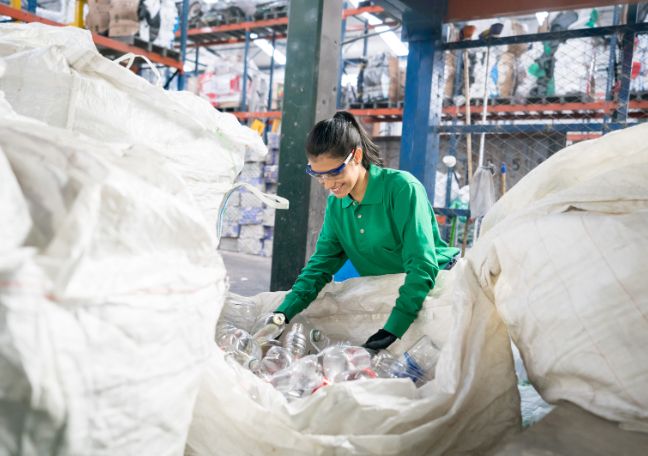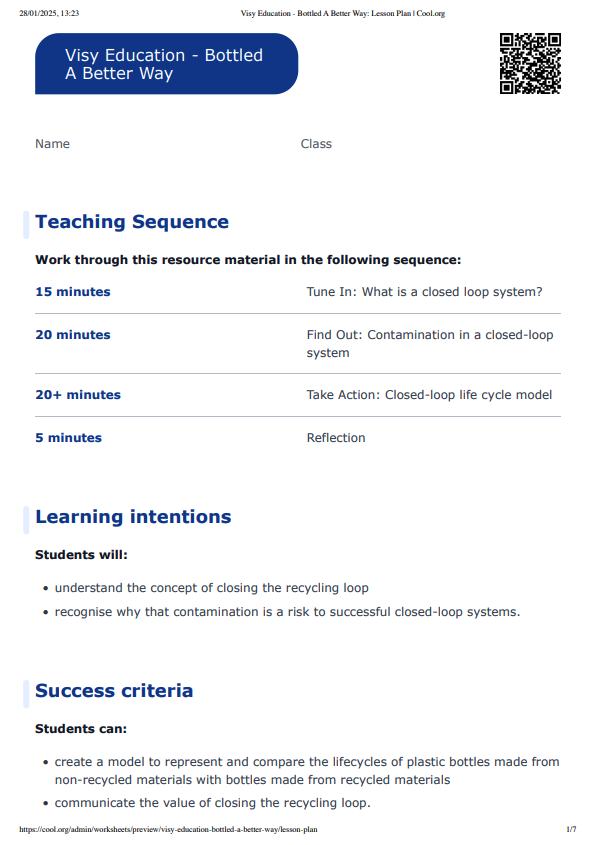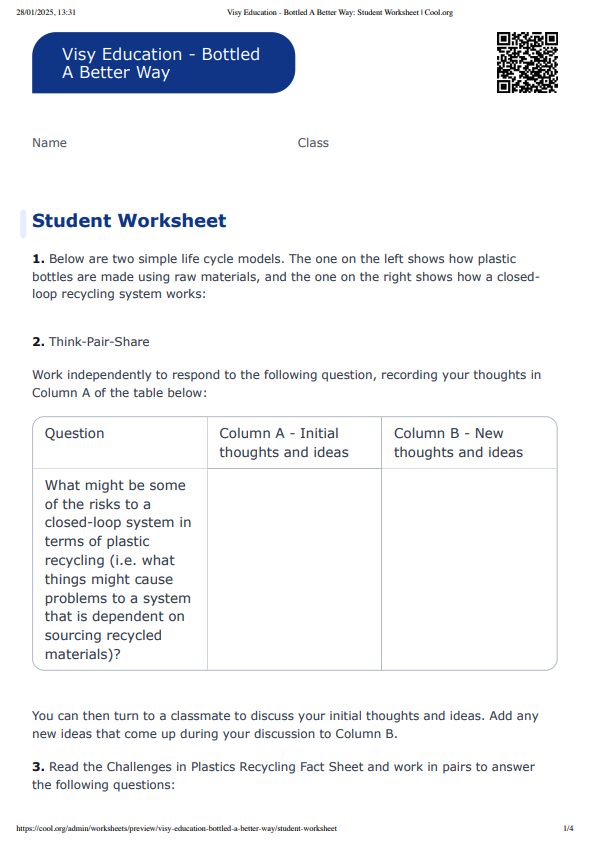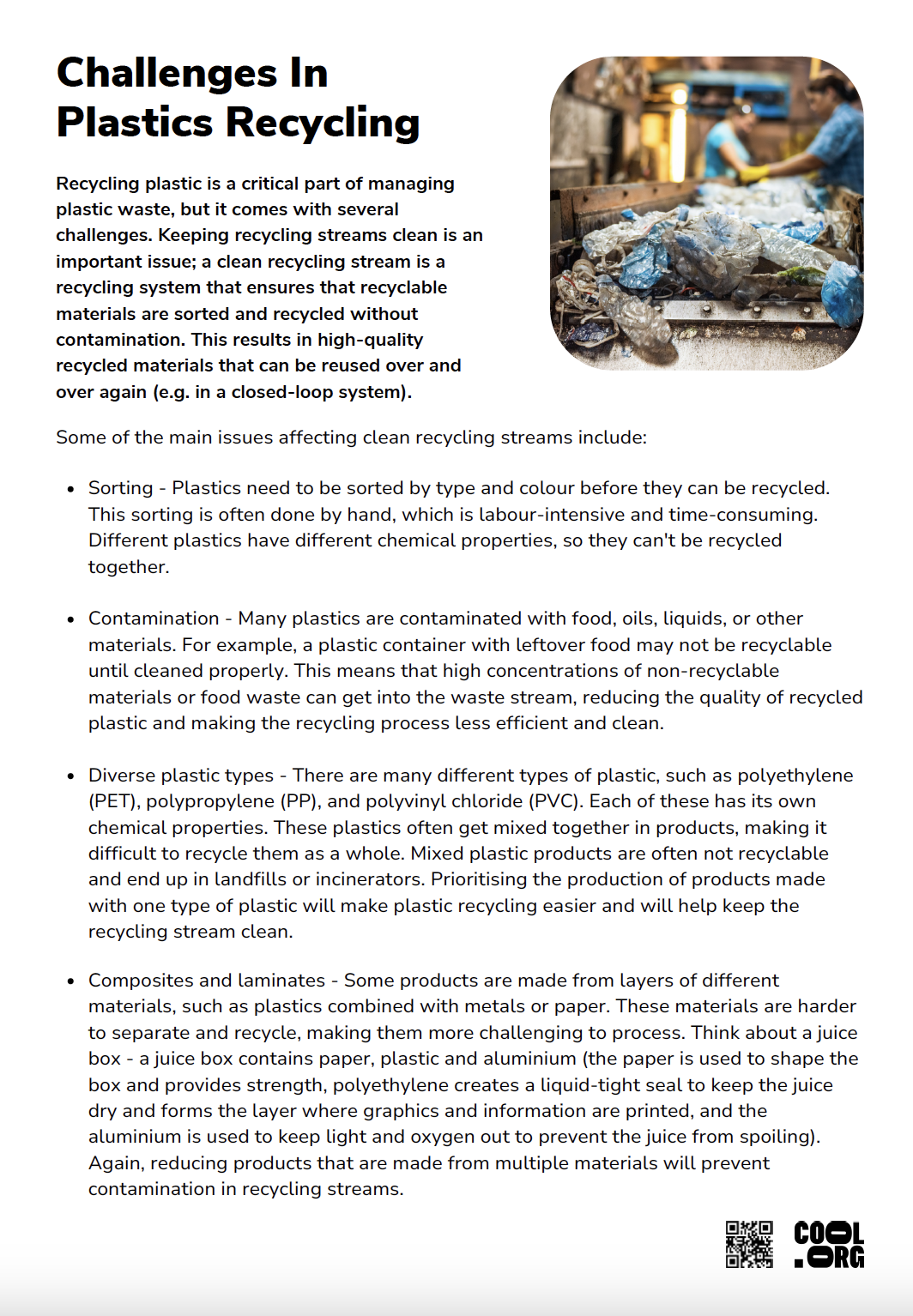Lesson summary
Students will examine the risk of contamination in closed-loop recycling systems. They will compare closed-loop plastic production with making plastic using raw materials and will consider the energy and water consumption and waste production in both systems. Students will create a 3D model of a closed-loop system.
Learning intentions:
Students will...
- understand the concept of closing the recycling loop
- recognise why that contamination is a risk to successful closed-loop systems.
Success criteria:
Students can...
- create a model to represent and compare the lifecycles of plastic bottles made from nonrecycled materials with bottles made from recycled materials
- communicate the value of closing the recycling loop.
Lesson guides and printables
Curriculum links
Select your curriculum from the options below.
Lesson details
Skills
This lesson is designed to build students’ competencies in the following skills:
- creative thinking
- critical thinking
- collaboration
- communication
- problem solving
Curriculum Mapping
Australian Curriculum (v9.0) content description:
Year 7&8, Science
Students learn to
- use a particle model to describe differences between pure substances and mixtures and apply understanding of properties of substances to separate mixtures (AC9S7U06)
- select and construct appropriate representations, including tables, graphs, models and mathematical relationships, to organise and process data and information (AC9S7I04)
- classify matter as elements, compounds or mixtures and compare different representations of these, including 2-dimensional and 3-dimensional models, symbols for elements and formulas for molecules and compounds (AC9S8U06)
- select and construct appropriate representations, including tables, graphs, models and mathematical relationships, to organise and process data and information (AC9S8I04).
Relevant parts of Year 7 achievement standards: Students use particle theory to explain the physical properties of substances and develop processes that separate mixtures. They select and construct appropriate representations to organise data and information.
Relevant parts of Year 8 achievement standards: Students classify and represent different types of matter and distinguish between physical and chemical change. They select and construct appropriate representations to organise and process data and information.
NSW Syllabus outcomes:
A student
- describes the observed properties and behaviour of matter, using scientific models and theories about the motion and arrangement of particles (SC4-16C)
- processes and analyses data from a first-hand investigation and secondary sources to identify trends, patterns and relationships, and draw conclusions( SC4-7WS).
General capabilities: Critical and Creative Thinking, Literacy
Cross-curriculum priority: Sustainability
Level of teacher scaffolding: Medium - facilitate class discussions and support students in life cycle model-making task.
UN Sustainable Development Goals
UN SDG 12: Ensure sustainable consumption and production patterns
- Target 12.5: By 2030, substantially reduce waste generation through prevention, reduction, recycling and reuse.
Resources Required
- Challenges in Plastics Recycling Fact Sheet
- Materials for model-making (e.g. paper straws, glue, sticky tape, coloured paper, and clean items destined for the recycling bin, such as cardboard and containers)
- Student Worksheet - one copy for each student.
Additional Info
This lesson has been developed in partnership with Visy. For over 70 years, Visy has been committed to finding sustainable solutions for Australia's and New Zealand’s recyclables and helping to reduce local landfills. Visy collects, receives, and sorts paper, cardboard, glass, plastics, steel, and aluminium from households, businesses, and schools to reuse these products and re-manufacture new packaging products.
Related Professional Learning
Fit Sustainability Into the Secondary Curriculum
Quick Summary: In this course, you will learn a holistic definition of sustainability, which goes beyond compost bins and solar panels and how to embed sustainability concepts to enrich your current curriculum without it being an add-on.




Welcome back!
Don't have an account yet?
Log in with:
Create your free Cool.org account.
Many of our resources are free, with an option to upgrade to Cool+ for premium content.
Already have an account?
Sign up with:
By signing up you accept Cool.org's Terms and Conditions(Opens in new tab) and Privacy Policy(Opens in new tab).